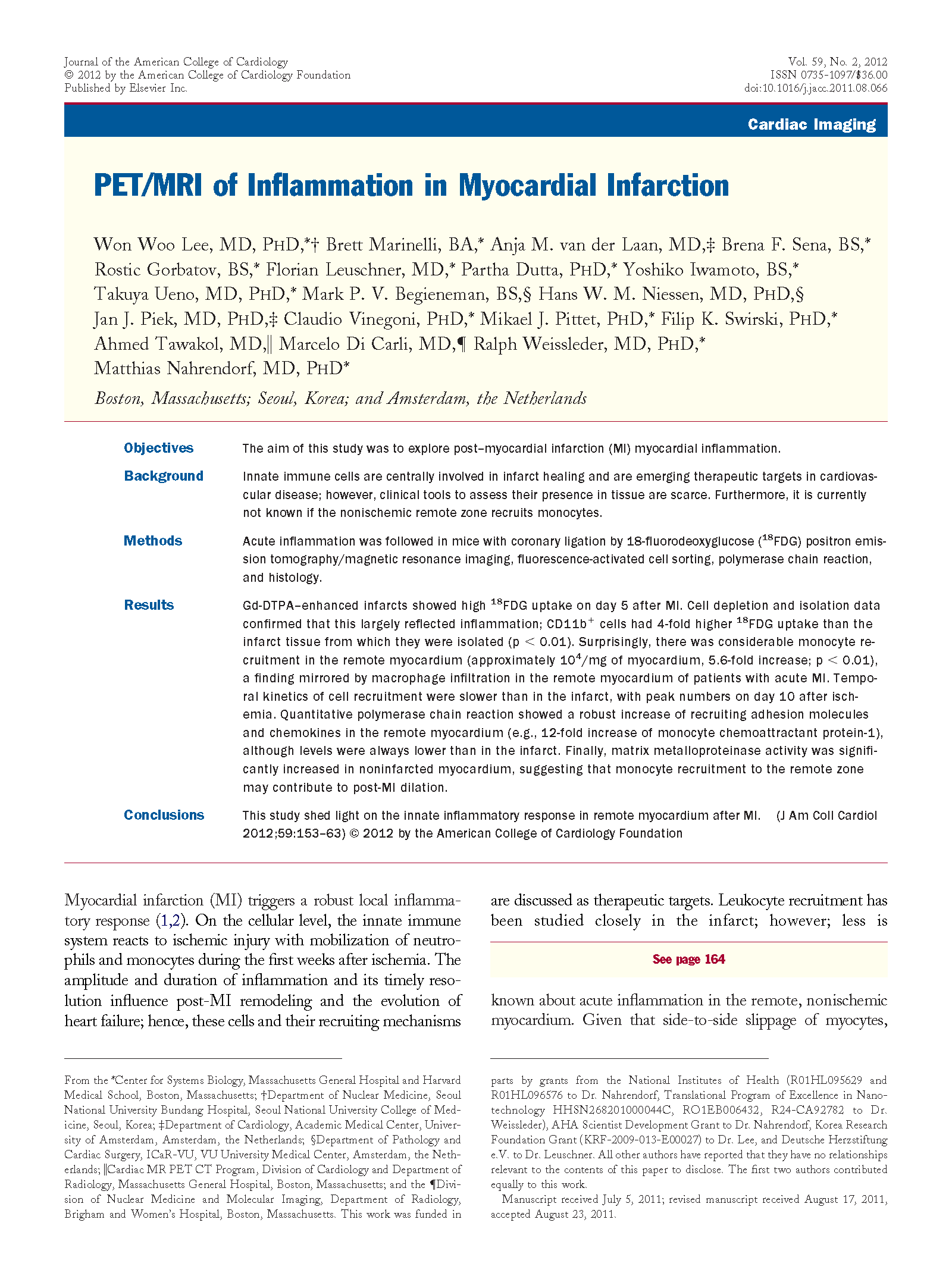PET/MRI of Inflammation in Myocardial Infarction
Journal of the American College of Cardiology
Abstract
"Objectives The aim of this study was to explore post-myocardial infarction (MI) myocardial inflammation. Background Innate immune cells are centrally involved in infarct healing and are emerging therapeutic targets in cardiovascular disease; however, clinical tools to assess their presence in tissue are scarce. Furthermore, it is currently not known if the nonischemic remote zone recruits monocytes. Methods Acute inflammation was followed in mice with coronary ligation by 18-fluorodeoxyglucose ((18)FDG) positron emission tomography/magnetic resonance imaging, fluorescence-activated cell sorting, polymerase chain reaction, and histology. Results Gd-DTPA-enhanced infarcts showed high (18)FDG uptake on day 5 after MI. Cell depletion and isolation data confirmed that this largely reflected inflammation; CD11b(+) cells had 4-fold higher (18)FDG uptake than the infarct tissue from which they were isolated (p < 0.01). Surprisingly, there was considerable monocyte recruitment in the remote myocardium (approximately 10(4)/mg of myocardium, 5.6-fold increase; p < 0.01), a finding mirrored by macrophage infiltration in the remote myocardium of patients with acute MI. Temporal kinetics of cell recruitment were slower than in the infarct, with peak numbers on day 10 after ischemia. Quantitative polymerase chain reaction showed a robust increase of recruiting adhesion molecules and chemokines in the remote myocardium (e.g., 12-fold increase of monocyte chemoattractant protein-1), although levels were always lower than in the infarct. Finally, matrix metalloproteinase activity was significantly increased in noninfarcted myocardium, suggesting that monocyte recruitment to the remote zone may contribute to post-MI dilation. Conclusions This study shed light on the innate inflammatory response in remote myocardium after MI. (J Am Coll Cardiol 2012; 59: 153-63) (C) 2012 by the American College of Cardiology Foundation"
Full citation
For attribution in academic contexts, please cite this work as:
| Lee, W. W., Marinelli, B., van der Laan, A. M., Sena, B. F., Gorbatov, R., Leuschner, F., Dutta, P., Iwamoto, Y., Ueno, T., Begieneman, M. P. V., Niessen, H. W. M., Piek, J. J., Vinegoni, C., Pittet, M. J., Swirski, F. K., Tawakol, A., Di Carli, M., Weissleder, R., & Nahrendorf#, M. (2012). PET/MRI of Inflammation in Myocardial Infarction. Journal of the American College of Cardiology, 59(2), 153–163. https://doi.org/10.1016/j.jacc.2011.08.066 |

Lee, W. W., Marinelli, B., van der Laan, A. M., Sena, B. F., Gorbatov, R., Leuschner, F., Dutta, P., Iwamoto, Y., Ueno, T., Begieneman, M. P. V., Niessen, H. W. M., Piek, J. J., Vinegoni, C., Pittet, M. J., Swirski, F. K., Tawakol, A., Di Carli, M., Weissleder, R., & Nahrendorf#, M. (2012). PET/MRI of Inflammation in Myocardial Infarction. Journal of the American College of Cardiology, 59(2), 153–163. https://doi.org/10.1016/j.jacc.2011.08.066